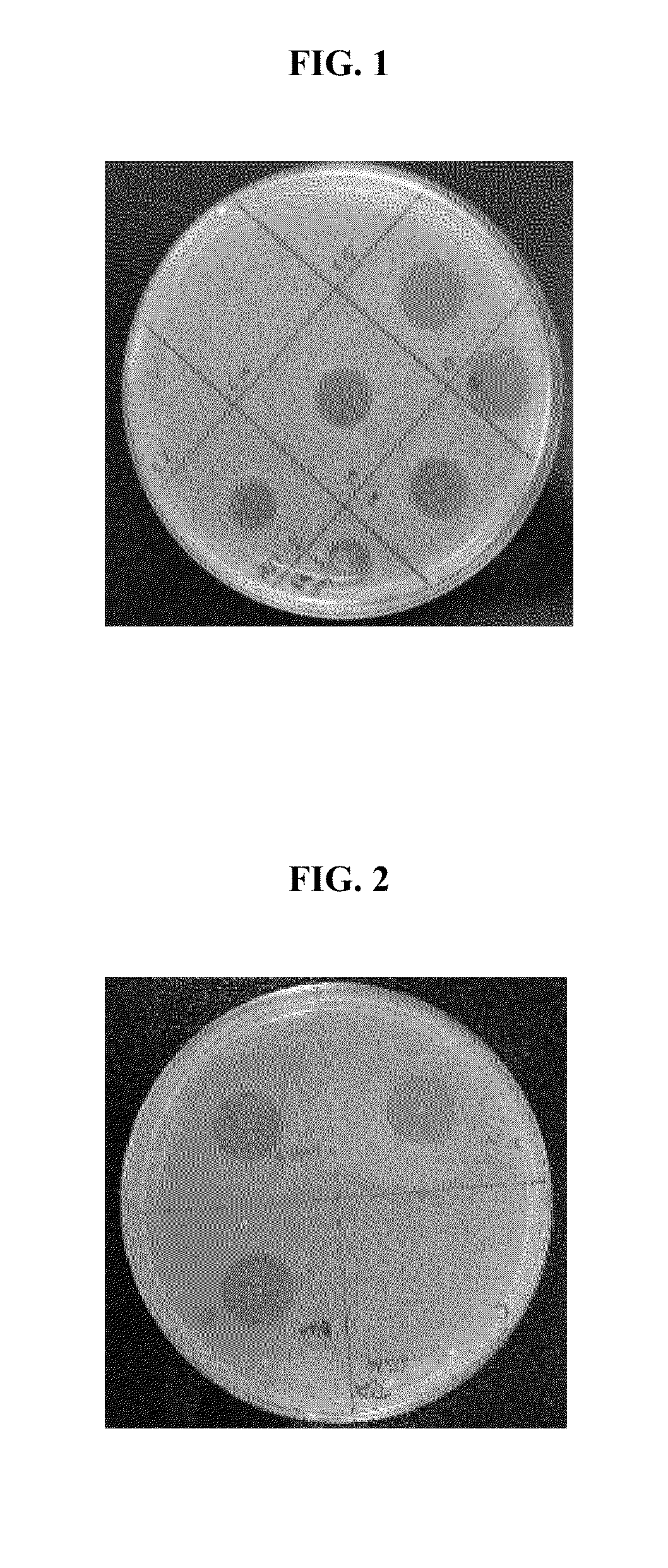Method for Prevention and Treatment of Salmonella Infection
a salmonella and treatment method technology, applied in the field of salmonella treatment, can solve the problems of reducing immunity, limiting the number of bacteria that can be infected with bacteriophage, and the damage caused by i>salmonella /i>infection, so as to achieve the effect of high specificity against salmonella, reducing immunity, and hardly accompanying side effects
- Summary
- Abstract
- Description
- Claims
- Application Information
AI Technical Summary
Benefits of technology
Problems solved by technology
Method used
Image
Examples
example 1
Isolation of Bacteriophage that can Destroy Salmonella
[0039]Bacteriophage that can destroy Salmonella was isolated from the nature or from animal samples. In the bacteriophage isolation, Salmonella Enteritidis was used as the representative Salmonella. This Salmonella Enteritidis (SE51) was isolated previously by the present inventors and then identified as Salmonella Enteritidis by the inventors.
[0040]Collected samples were loaded in TSB (Tryptic Soy Broth) medium (casein digest, 17 g / L; soybean digest, 3 g / L; dextrose, 2.5 g / L; NaCl, 5 g / L; dipotassium phosphate, 2.5 g / L) inoculated with Salmonella Enteritidis (1 / 1000), followed by shaking culture for 3-4 hours at 37° C. Upon completion of the culture, centrifugation was performed at 8,000 rpm for 20 minutes and the supernatant was recovered. Salmonella was inoculated in the recovered supernatant (1 / 1000), followed by shaking culture for 3-4 hours at 37° C. This procedure was repeated 5 times in total in order to increase bacteri...
example 2
Extraction of Bacteriophage SP-1 Genome and Sequencing Thereof
[0045]Bacteriophage SP-1 genome was extracted as follows using the bacteriophage suspension obtained in Example 1. To eliminate Salmonella DNA and RNA which might be included in the suspension, DNase I and RNase A were added to 10 mL of the bacteriophage suspension (200 U each), which stood at 37° C. for 30 minutes. 30 minutes later, to neutralize DNase I and RNase A activity, 500 μL of 0.5 M ethylenediaminetetraacetic acid (EDTA) was added, which stood for 10 minutes. The solution stood at 65° C. for another 10 minutes, then 100 μL of proteinase K (20 mg / mL) was added, followed by reaction at 37° C. for 20 minutes to break the outer wall of the bacteriophage. Then, 500 μL of 10% sodium dodecyl sulfate (SDS) solution was added thereto, followed by reaction at 65° C. for one hour. One hour later, 10 μL of the mixed solution comprising phenol:chloroform:isoamylalcohol at the concentration ratio of 25:24:1 was added thereto ...
example 3
Killing Activity of Bacteriophage SP-1 to Various Salmonella Bacteria
[0051]Various Salmonella bacteria were used to investigate killing activity of the selected bacteriophage SP-1. For the investigation, clear zone formation was first observed by spot assay by the same manner as described in Example 1. Salmonella bacteria used for this assay were Salmonella Enteritidis (SE51), Salmonella Gallinarum (SG36), Salmonella Pullorum (SP-11), Salmonella Typhimurium (ST2), Salmonella Choleraesuis (ATCC 9120), Salmonella Dubulin (BA584), and Salmonella Durby. Salmonella Choleraesuis (ATCC 9120) was the standard strain, and Salmonella Dubulin (BA584) and Salmonella Durby were the isolates distributed from National Veterinary Research & Quarantine Service Korea. Salmonella Enteritidis (SE51), Salmonella Gallinarum (SG36), Salmonella Pullorum (SP-11), and Salmonella Typhimurium (ST2) were the isolates isolated and identified by the inventors. The results of the related experiments are shown in F...
PUM
| Property | Measurement | Unit |
|---|---|---|
| pH | aaaaa | aaaaa |
| volume ratio | aaaaa | aaaaa |
| morphology | aaaaa | aaaaa |
Abstract
Description
Claims
Application Information
 Login to View More
Login to View More - R&D
- Intellectual Property
- Life Sciences
- Materials
- Tech Scout
- Unparalleled Data Quality
- Higher Quality Content
- 60% Fewer Hallucinations
Browse by: Latest US Patents, China's latest patents, Technical Efficacy Thesaurus, Application Domain, Technology Topic, Popular Technical Reports.
© 2025 PatSnap. All rights reserved.Legal|Privacy policy|Modern Slavery Act Transparency Statement|Sitemap|About US| Contact US: help@patsnap.com



